Regular exercise has many benefits: it helps keep your heart, lungs, bones and muscles strong. It also helps to improve your mood and energy level and even helps you sleep better.
Exercise is just as important if you have enthesitis-related arthritis (ERA). ERA is a form of juvenile idiopathic arthritis (JIA). Children and teens with ERA not only have joint swelling or inflammation from arthritis, but also have enthesitis. Enthesitis is swelling or inflammation of the entheses, the connective tissue where tendons or ligaments attach to bone.
Physical activity can include stretching, strengthening and aerobic activities. You should always start a new exercise program slowly and gradually increase it in intensity over time. You should follow a formal exercise program at least three to four times a week.
Stretching and flexibility
Stretching and flexibility are an important part of any exercise program. Before stretching, always warm up your muscles. You can do this by walking around or riding a stationary bike for a few minutes. If you are very stiff, a warm shower or bath may help you loosen up. You should do stretching exercises slowly and hold them until you feel a medium stretch. The stretch should not feel painful.
The following stretching exercises will help you stretch your back and hip muscles and keep them flexible:

Lie on your back and pull one knee toward your chest while keeping the other leg straight along the floor. Hold for 10 seconds. Repeat three times with each leg.
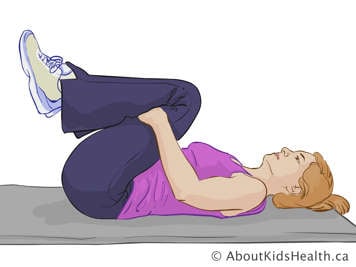
Lie on your back, and pull both knees to your chest. Hold for 10 seconds. Repeat three times.
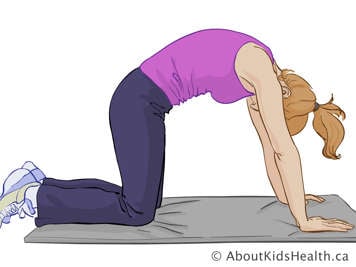
Starting on your hands and knees, round your back up like a cat. Hold for five seconds. Then, make your back hollow by dropping your tummy. Hold for five seconds. Repeat both parts five times.
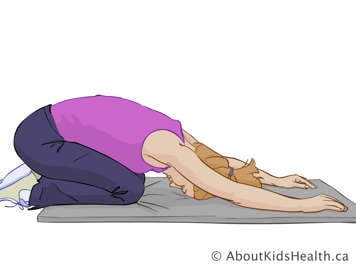
Sit back on your heels, and move your hands forward along the floor, until you feel a medium stretch in your upper body and shoulders. Take a deep breath and walk your fingers forward a little to increase the stretch. Hold for 10 seconds. Then, rock your upper body from side to side, as you stretch one arm slightly further than the other, alternating arms. Repeat 10 times with each arm.
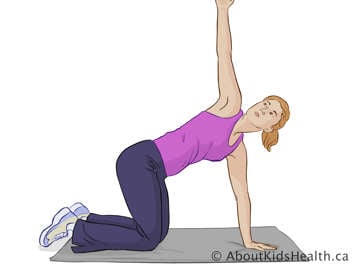
Start in four-point (on your hands and knees). Lift one arm up behind you and look up towards your out-stretched hand. Hold for five seconds. Repeat five times with each arm.

Stand tall and bend sideways by sliding your hand down the side of your leg. Do not lift a foot off the floor and do not bend forward. Hold for five seconds. Repeat five times on each side.

Hold your hand and forearm at shoulder level on the corner of a wall or in a doorframe. Put the leg of the same side a little bit forward. Rotate your body away from your arm until you feel a stretch in your chest muscles. Hold for 10 seconds. Repeat three times with each arm.
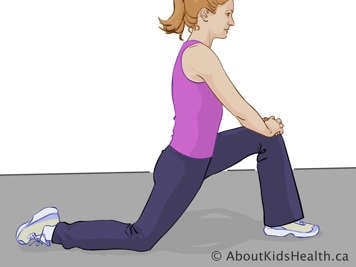
Start in a kneeling position. Place one foot forward on the floor, so you are making a 90-degree angle with your foot. Prop up your arms on your knee to stabilize your trunk. Keep your lower back leg straight along the ground behind you. Make sure both feet are pointed straight. Push your hips forward until you feel a stretch in your hip flexors, which are the front part of your hip. Tighten your stomach muscles to make sure your back does not arch. Hold each stretch for 20 to 30 seconds. Repeat three times with each leg.

Lie on your stomach with your left arm and left leg extended straight along the floor. Bend your right leg by holding your ankle or foot with your right hand and pulling it gently toward your buttocks until you feel a stretch in your thigh. Keep your hips on the floor. Hold for 20 to 30 seconds. Repeat three times with each leg.
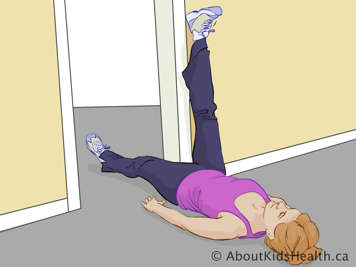
Lie on the floor with one leg outstretched through a doorway and the other leg extended straight up the wall. Try to bring your bottom as close to the wall as you can. To increase the stretch, loop a towel around the foot that is extended up the wall and pull gently. Try to lift your heel away from the wall. Hold stretch for 60 to 90 seconds. Complete stretch one time with each leg.
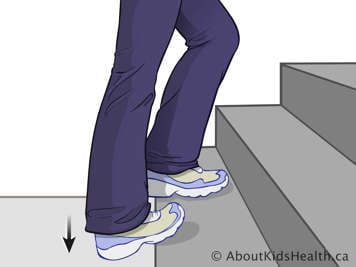
Stand on a step with one heel over the edge. Hold on to a railing, wall or some other form of support. Let the weight of your body stretch your heel towards the floor. Hold for 20 to 30 seconds and repeat three to five times with each leg.
Strengthening and posture
The following exercises will help you improve the overall strength of your muscles and your posture.
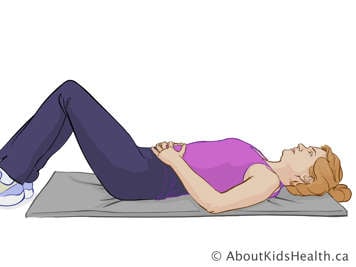
Tighten your lower tummy muscles by pushing your back flat into the floor. Hold for five deep breaths. Repeat 10 to 30 times.

If you want to make this stretch harder, you can tighten your lower tummy muscles and lift your feet off the floor, bringing your knees up to a 90-degree angle. Hold for three to five deep breaths and lower your legs slowly. Make sure your back is flat and your tummy muscles are tight, even when you are lowering your legs. Repeat 10 to 30 times.
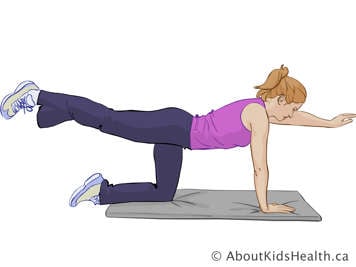
Lie on your tummy or up on all fours (hands and knees). Lift your left arm and your right leg at the same time. Hold for five seconds and then switch your arm and your leg. Repeat 10 to 30 times on each side.
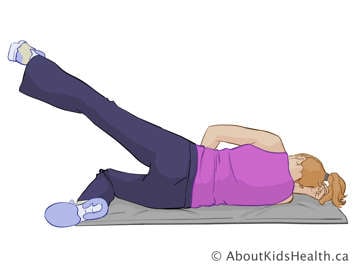
Lie on your side with your top shoulder, hip, knee and ankle all in a line. Bend your bottom leg at a 90-degree angle for support. Lift your top leg slowly. Hold for five seconds. Repeat 10 to 30 times. You can try adding a weight to your ankle to make the exercise more difficult as long as your ankles are not swollen or painful. Make sure your top leg is in the correct position by pretending that you are holding a glass of water on your leg. When lifting and lowering your leg, make sure that you do not drop or spill the glass of water. That way your leg should stay perfectly sideways.
Be careful using weights
In general, you should not use resistance, such as weights, in the area of an acutely swollen joint. Until your body has reached full adult development, usually between 15 and 18 years of age, you should avoid the following exercises so that you do not risk injuring growing bones, joints and soft tissues:
- strength training with heavy weights
- power lifting
- body building
Aerobic exercise
Aerobic exercise is very important for your health. It includes any activity that can increase your breathing and heart rate continuously for a period of time. Aim to try any moderate to vigorous activity you enjoy for at least 60 minutes a day.
Good forms of aerobic exercise include:
- walking
- swimming*
- biking
- hiking
- dancing
- hockey
- cricket
- soccer
- roller blading
*Swimming is a great exercise, but to keep your bones healthy, it is important to do some activities on land that involve walking or running.
Everyday tips for healthy joints and posture
There are small things that you can do every day to improve your posture and make sure your joints stay healthy.
- When you are at the computer, sit in a comfortable chair with your feet flat on the floor. Your knees should be at a 90-degree angle to your hips and the back of the chair should support your back. Your desk or computer should be at the proper height so that your forearms or wrists can rest on the surface comfortably. Once in this position, your computer screen should be at eye height.
- When you have to carry heavy books, use a backpack with both shoulder straps. Do not carry them in a bag over one shoulder.